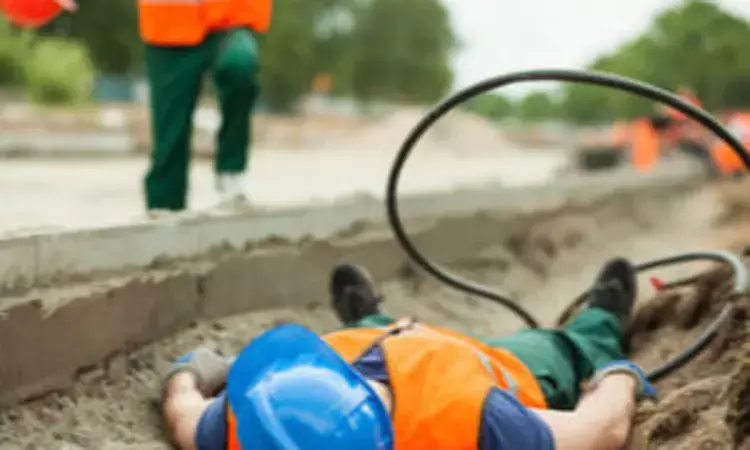- Home
- Medical news & Guidelines
- Anesthesiology
- Cardiology and CTVS
- Critical Care
- Dentistry
- Dermatology
- Diabetes and Endocrinology
- ENT
- Gastroenterology
- Medicine
- Nephrology
- Neurology
- Obstretics-Gynaecology
- Oncology
- Ophthalmology
- Orthopaedics
- Pediatrics-Neonatology
- Psychiatry
- Pulmonology
- Radiology
- Surgery
- Urology
- Laboratory Medicine
- Diet
- Nursing
- Paramedical
- Physiotherapy
- Health news
- Fact Check
- Bone Health Fact Check
- Brain Health Fact Check
- Cancer Related Fact Check
- Child Care Fact Check
- Dental and oral health fact check
- Diabetes and metabolic health fact check
- Diet and Nutrition Fact Check
- Eye and ENT Care Fact Check
- Fitness fact check
- Gut health fact check
- Heart health fact check
- Kidney health fact check
- Medical education fact check
- Men's health fact check
- Respiratory fact check
- Skin and hair care fact check
- Vaccine and Immunization fact check
- Women's health fact check
- AYUSH
- State News
- Andaman and Nicobar Islands
- Andhra Pradesh
- Arunachal Pradesh
- Assam
- Bihar
- Chandigarh
- Chattisgarh
- Dadra and Nagar Haveli
- Daman and Diu
- Delhi
- Goa
- Gujarat
- Haryana
- Himachal Pradesh
- Jammu & Kashmir
- Jharkhand
- Karnataka
- Kerala
- Ladakh
- Lakshadweep
- Madhya Pradesh
- Maharashtra
- Manipur
- Meghalaya
- Mizoram
- Nagaland
- Odisha
- Puducherry
- Punjab
- Rajasthan
- Sikkim
- Tamil Nadu
- Telangana
- Tripura
- Uttar Pradesh
- Uttrakhand
- West Bengal
- Medical Education
- Industry
Electrical injury linked to complex pain & movement disorders later in lives of patients: study

Australia: E.W.Y. Lun, A.C. Tan, C.J. Andrews et al. et al retrospectively analyzed 15 cases from 2004 to 2019 of adult claimants assessed in a medico-legal practice for complex chronic pain disorders secondary to Electrical Injury (EI). Extensive biopsychosocial information, including 165 data items on pre- and post-injury observations, was collected on each. Cutaneous and deep pressure somatosensory examination was performed and questionnaires for psychological evaluation and restless legs syndrome completed. A comprehensive literature review and descriptive analysis was conducted.
• Pre-injury, most claimants worked (12/15), did not receive government benefits (14/15) and had no primary pain disorder (9/15).
• EIs were severe (14/15), where chronic post-traumatic pain, typically high impact with nociplastic features, was regional in 5 and widespread in 10.
• The primary site of injury was the hand in all cases.
• Most (10/15) patients presented to an emergency department within a week, and 5 required to be admitted as a hospital inpatient.
• Secondary musculoskeletal and head injuries were common (14/15), and 6 claimants required surgery.
• Somatosensory signs in wide distribution in all cases implied central sensitization.
• Clinically significant sleep disturbance was reported in all but one case, prominent daytime fatigue in 8, major inactivity in 4, with at least 5 kg weight gain in 5.
• Movement disorders included digital dyskinesia (5/15), involuntary muscle contractions (7/15) and restless legs syndrome in 7.
• Diagnostic and Statistical Manual of Mental Disorders (DSM-5) post-traumatic stress disorder (PTSD) criteria were met in 12/15, and 14/15 experienced depression and impaired sleep.
• Severe social impacts, notably including loss of employment resulting in financial stresses, were common.
The authors concluded that - The extensive and long persistent clinical features attributed to EI had such a level of consistency between the 15 cases that the most highly shared features might be considered a syndromic aid to diagnosis. The key features included chronic pain, widespread especially in those with secondary musculoskeletal injury; impaired sleep and fatigue; post-traumatic stress, anxiety, depression, often major; somatosensory stimulus-response test responses implying central sensitization; movement disorders, particularly restless legs syndrome; and multiple seriously adverse social outcomes. Improved knowledge of this post-EI syndrome by the medical profession will assist in much needed improvement in the diagnosis, assessment and management. There is a need for early and continuing biopsychosocial assessment and for more education in pain medicine including somatosensory testing.
Key Words: Electrical injury, Biopsychosocial, Post traumatic stress disorder (PTSD), Central sensitization, Movement disorders, Chronic pain, Medicolegal, Case series, Injury.
Further Reading:
Electrical injury: Chronic pain, somatosensory dysfunction, post traumatic stress and movement disorders
Elizabeth W Y Lun, Aidan C Tan, Christopher J Andrews, G. David Champion.
Injury 53 (2022) 1667–1677
MBBS, Dip. Ortho, DNB ortho, MNAMS
Dr Supreeth D R (MBBS, Dip. Ortho, DNB ortho, MNAMS) is a practicing orthopedician with interest in medical research and publishing articles. He completed MBBS from mysore medical college, dip ortho from Trivandrum medical college and sec. DNB from Manipal Hospital, Bengaluru. He has expirence of 7years in the field of orthopedics. He has presented scientific papers & posters in various state, national and international conferences. His interest in writing articles lead the way to join medical dialogues. He can be contacted at editorial@medicaldialogues.in.
Dr Kamal Kant Kohli-MBBS, DTCD- a chest specialist with more than 30 years of practice and a flair for writing clinical articles, Dr Kamal Kant Kohli joined Medical Dialogues as a Chief Editor of Medical News. Besides writing articles, as an editor, he proofreads and verifies all the medical content published on Medical Dialogues including those coming from journals, studies,medical conferences,guidelines etc. Email: drkohli@medicaldialogues.in. Contact no. 011-43720751


